Transpiration Water Consumption by Salix matsudana and Populus simonii and Water Use Patterns at Different Developmental Stages on Sandy Land
Abstract
1. Introduction
2. Materials and Methods
2.1. Overview of the Study Area
2.2. Sample Collection and Determination
2.2.1. Experimental Sample Collection
2.2.2. Measurement of Soil Water Content
- Shallow depth: 0~60 cm
- Middle depth: 60~150 cm
- Deep depth: 150~210 cm
2.2.3. Analysis of Hydrogen and Oxygen Isotope Sample Measurement
2.2.4. Measurement of Transpiration Sap Flow
2.2.5. Data Processing
2.2.6. Flowchart for Methodology
3. Results
3.1. Temperature and Rainfall
3.2. Changes of Soil Water Content
3.3. Composition of Xylem Water, Soil Water, and Groundwater in Salix matsudana and Populus simonii
3.4. Seasonal Variation of Water Use Patterns of Salix matsudana and Populus simonii
3.5. Changes of Sap Flow Rate of Salix matsudana and Populus simonii
4. Discussion
4.1. Isotope Composition and Seasonal Variation in Various Water Bodies
4.2. Water Use Patterns of Salix matsudana and Populus simonii
4.3. Changes of Transpiration Sap Flow of Salix matsudana and Populus simonii
5. Conclusions
Author Contributions
Funding
Data Availability Statement
Acknowledgments
Conflicts of Interest
References
- Zhang, Z.; Wang, W.; Gong, C.; Zhao, M.; Franssen, H.-J.H.; Brunner, P. Salix psammophila afforestations can cause a decline of the water table, prevent groundwater recharge and reduce effective infiltration. Sci. Total Environ. 2021, 780, 146336. [Google Scholar] [CrossRef]
- Brunel, J.-P.; Walker, G.R.; Kennett-Smith, A.K. Field validation of isotopic procedures for determining sources of water used by plants in a semi-arid environment. J. Hydrol. 1995, 167, 351–368. [Google Scholar] [CrossRef]
- Yu, X.; Liu, H.; Wang, L.; Wang, Q.; Liu, X.; Wen, L.; Dong, S.; Pan, B. Analysis on Water Sources of Riverbank Vegetation in Tributary of Yellow River Based on Stable lsotope Technique. J. Soil. Water Conserv. 2021, 41, 75–82+91. (In Chinese) [Google Scholar] [CrossRef]
- Ehleringer, J.R.; Dawson, T.E. Water uptake by plants: Perspectives from stable isotope composition. Plant Cell Environ. 2010, 15, 1073–1082. [Google Scholar] [CrossRef]
- Wang, Y.L.; Liu, L.C.; Gao, Y.H.; Li, G.; Zhao, J.C.; Xie, M. Analysis of water sources of plants in artificial sand-fixation vegetation area based on large rainfall events. Chin. J. Appl. Ecol. 2016, 27, 1053–1060. (In Chinese) [Google Scholar] [CrossRef]
- Youri, R.; Mathieu, J. Reviews and syntheses: Isotopic approaches to quantify root water uptake: A review and comparison of methods. Biogeosciences 2017, 14, 2199–2224. [Google Scholar] [CrossRef]
- Penna, D.; Hopp, L.; Scandellari, F.; Allen, S.T.; Benettin, P.; Beyer, M.; Geris, J.; Klaus, J.; Marshall, J.D.; Schwendenmann, L. Ideas and perspectives: Tracing terrestrial ecosystem water fluxes using hydrogen and oxygen stable isotopes—Challenges and opportunities from an interdisciplinary perspective. Biogeosciences 2018, 15, 6399–6415. [Google Scholar] [CrossRef]
- Montgomery, J.A.; Klimas, C.A.; Arcus, J.; Deknock, C.; Rico, K.; Rodriguez, Y.; Vollrath, K.; Webb, E.; Williams, A. Soil quality assessment is a necessary first step for designing urban green infrastructure. J. Environ. Qual. 2016, 45, 18–25. [Google Scholar] [CrossRef]
- Midwood, A.J.; Boutton, T.W.; Archer, S.R.; Watts, S.E. Water use by woody plants on contrasting soils in a savanna parkland: Assessment with δ2H and δ18O. Plant Soil. 1998, 205, 13–24. [Google Scholar] [CrossRef]
- West, A.G.; Dawson, T.E.; February, E.C.; Midgley, G.F.; Bond, W.J.; Aston, T.L. Diverse functional responses to drought in a Mediterranean-type shrubland in South Africa. New Phytol. 2012, 195, 396–407. [Google Scholar] [CrossRef]
- Peng, W.; Song, X.; Han, D.; Xin, L. A study of root water uptake of crops indicated by hydrogen and oxygen stable isotopes: A case in Shanxi Province. Agric. Manag. Water Qual. 2010, 97, 475–482. (In Chinese) [Google Scholar] [CrossRef]
- McCole, A.A.; Stern, L.A. Seasonal water use patterns of Juniperus ashei on the Edwards Plateau, Texas, based on stable isotopes in water. J. Hydrol. 2007, 342, 238–248. [Google Scholar] [CrossRef]
- Darrouzet-Nardi, A.; D’Antonio, C.M.; Dawson, T.E. Depth of water acquisition by invading shrubs and resident herbs in a Sierra Nevada meadow. Plant Soil. 2006, 285, 31–43. [Google Scholar] [CrossRef]
- Ding, Y.; Nie, Y.; Schwinning, S.; Chen, H.; Yang, J.; Zhang, W.; Wang, K. A novel approach for estimating groundwater use by plants in rock-dominated habitats. J. Hydrol. 2018, 565, 760–769. [Google Scholar] [CrossRef]
- Zhao, Y.; Wang, Y.; He, M.; Tong, Y.; Zhou, J.; Guo, X.; Liu, J.; Zhang, X. Transference of Robinia pseudoacacia water-use patterns from deep to shallow soil layers during the transition period between the dry and rainy seasons in a water-limited region. For. Ecol. Manag. 2019, 457, 117727. [Google Scholar] [CrossRef]
- Jackson, P.C.; Cavelier, J.; Goldstein, G.; Meinzer, F.C.; Holbrook, N.M. Partitioning of water resources among plants of a lowland tropical forest. Oecologia 1995, 101, 197–203. [Google Scholar] [CrossRef] [PubMed]
- Schwendenmann, L.; Pendall, E.; Sanchez-Bragado, R.; Kunert, N.; Hulscheer, D. Tree water uptake in a tropical plantation varying in tree diversity: Interspecific differences, seasonal shifts and complementarity. Ecohydrology 2015, 8, 1–12. [Google Scholar] [CrossRef]
- Hao, B.; Ai, N.; Jia, Y.; Zong, Q.; Liu, J.; Liu, C. Soil water characteristics of different vegetation types in the south of MU Us Sandy Land. J. Arid Environ. 2020, 34, 196–200. (In Chinese) [Google Scholar] [CrossRef]
- Ohte, N.; Koba, K.; Yoshikawa, K.; Sugimoto, A.; Matsuo, N.; Wang, K.L. Water Utilization of Natural and Planted Trees in the Semiarid Desert of Inner Mongolia, China. Ecol. Appl. 2003, 13, 337–351. [Google Scholar] [CrossRef]
- Li, R.; Huang, L.; Pei, Y.; Shao, M.; Zhang, Y. Water Use Source of Salix psammophila in Gechougou Small Watershedof Mu Us Sandy Land. J. Soil Water Conserv. 2021, 35, 122–130. (In Chinese) [Google Scholar] [CrossRef]
- Granier, A. Evaluation of transpiration in a Douglas-fir stand by means of sap flow measurements. Tree Physiol. 1987, 3, 309–320. [Google Scholar] [CrossRef]
- Yin, L.H.; Huang, J.T.; Wang, X.Y.; Dong, J.Q.; Ma, H.Y.; Zhang, J. Characteristics of night time sap flow of Salix matsudana and Populus simonii in Yulin, Shaanxi. J. Northwest A F Univ. 2013, 41, 85–90. (In Chinese) [Google Scholar] [CrossRef]
- Gazis, C.; Feng, X.H. A stable isotope study of soil water: Evidence for mixing and preferential flow paths. Geoderma 2004, 119, 97–111. [Google Scholar] [CrossRef]
- Allen, S.T.; Kirchner, J.W.; Braun, S.; Siegwolf, R.T.W.; Goldsmith, G.R. Seasonal origins of soil water used by trees. Hydrol. Earth Syst. Sci. 2019, 23, 1199–1210. [Google Scholar] [CrossRef]
- Wang, J.; Fu, B.; Lu, N.; Zhang, L. Seasonal variation in water uptake patterns of three plant species based on stable isotopes in the semi-arid Loess Plateau. Sci. Total Environ. 2017, 609, 27–37. [Google Scholar] [CrossRef] [PubMed]
- Bowen, G.J.; Putman, A.; Brooks, J.R.; Bowling, D.R.; Oerter, E.J.; Good, S.P. Inferring the source of evaporated waters using stable H and O isotopes. Oecologia 2017, 187, 1025–1039. [Google Scholar] [CrossRef]
- Tian, C.; Meng, P.; Zhang, J.; Sun, S.; He, C.; Jia, C.; Li, J. Seasonal characteristics of 8D and 8180 in precipitation and its water vaporsources in the Xiaolangdi Reservoir area of Yellow River, China. J. Appl. Ecol. 2015, 26, 3579–3587. (In Chinese) [Google Scholar] [CrossRef]
- Eggemeyer, K.D.; Awada, T.; Harvey, F.E.; Wedin, D.A.; Zhou, X.; Zanner, C.W. Seasonal changes in depth of water uptake for encroaching trees Juniperus virginiana and Pinus ponderosa and two dominant C4 grasses in a semiarid grassland. Tree Physiol. 2009, 29, 157–169. [Google Scholar] [CrossRef]
- Liu, Z.; Yu, X.; Deng, W.; Jia, G.; Jia, J.; Lou, Y.; Li, H. Water sources of Pinus tabuliformis and Platycladus orientalis before and after rain in northern China. J. Soil Water Conserv. 2016, 14, 111–119. (In Chinese) [Google Scholar] [CrossRef]
- Liu, Z.; Yu, X.; Jia, G.; Jia, J.; Lou, Y.; Zhang, K. Water Use Characteristics of Platycladus orientalis and Quercus variabilis in Beijing Mountain Area. Sci. Silvae Sin. 2016, 52, 22–30. (In Chinese) [Google Scholar]
- Hasselquist, N.J.; Allen, M.F. Increasing demands on limited water resources: Consequences for two endangered plants in Amargosa Valley, USA. Am. J. Bot. 2009, 96, 620–626. [Google Scholar] [CrossRef]
- Zhang, H.; Jia, G.; Liu, Z.; Yu, X.; Cao, J.; Wang, H.; Song, B.; Zeng, J. Water utilization characteristics of the degraded poplar shelterbelts inZhangbei, Hebei, China. J. Appl. Ecol. 2018, 29, 1381–1388. (In Chinese) [Google Scholar] [CrossRef]
- Ward, D.; Wiegand, K.; Getzin, S. Walter’s two-layer hypothesis revisited—Back to the roots! S. Afr. J. Bot. 2013, 86, 141. [Google Scholar] [CrossRef][Green Version]
- Roux, X.L.; Bariac, T.; Mariotti, A. Spatial partitioning of the soil water resource between grass and shrub components in a West African humid savanna. Oecologia 1995, 104, 147–155. [Google Scholar] [CrossRef]
- Yue, G.Y.; Zhao, H.L.; Zhang, T.H.; Yun, J.Y.; Niu, L.; He, Y.H. Characteristics of Caragana microphylla sap flow and water consumptionunder different weather conditions on Horqin sandy land of northeast China. J. Appl. Ecol. 2007, 18, 2173–2178. (In Chinese) [Google Scholar]
- Jia, T.; Liu, T.; Duan, L.; Zhang, Y.; Tong, X.; Bao, Y. Transpiration and water consumption of poplar trees in semi-arid dunemeadow transition zone. Chin. J. Ecol. 2020, 39, 3255–3264. (In Chinese) [Google Scholar] [CrossRef]
- Li, L.; Nie, H.; Jing, Q.; Zhang, Y.; Lan, Y.; Zhu, L. Correlations between the Transpiration Water Consumption of Hedysarummongolicum and Environmental Factors in Mu Us Sandy Land. Water SA 2022, 12, 103–109+118. (In Chinese) [Google Scholar] [CrossRef]
- Yu, F.; Chen, L.; Wang, F.; Liu, H.; Du, J.M.; Guo, Y.Z.; Li, H.X. The Study on Sap Flow and Transpiration of Artificial Caragana korshinkii in the Arid Area of Central Ningxia Hui Autonomous Region. Soil Water Conserv. 2011, 18, 143–147. (In Chinese) [Google Scholar]
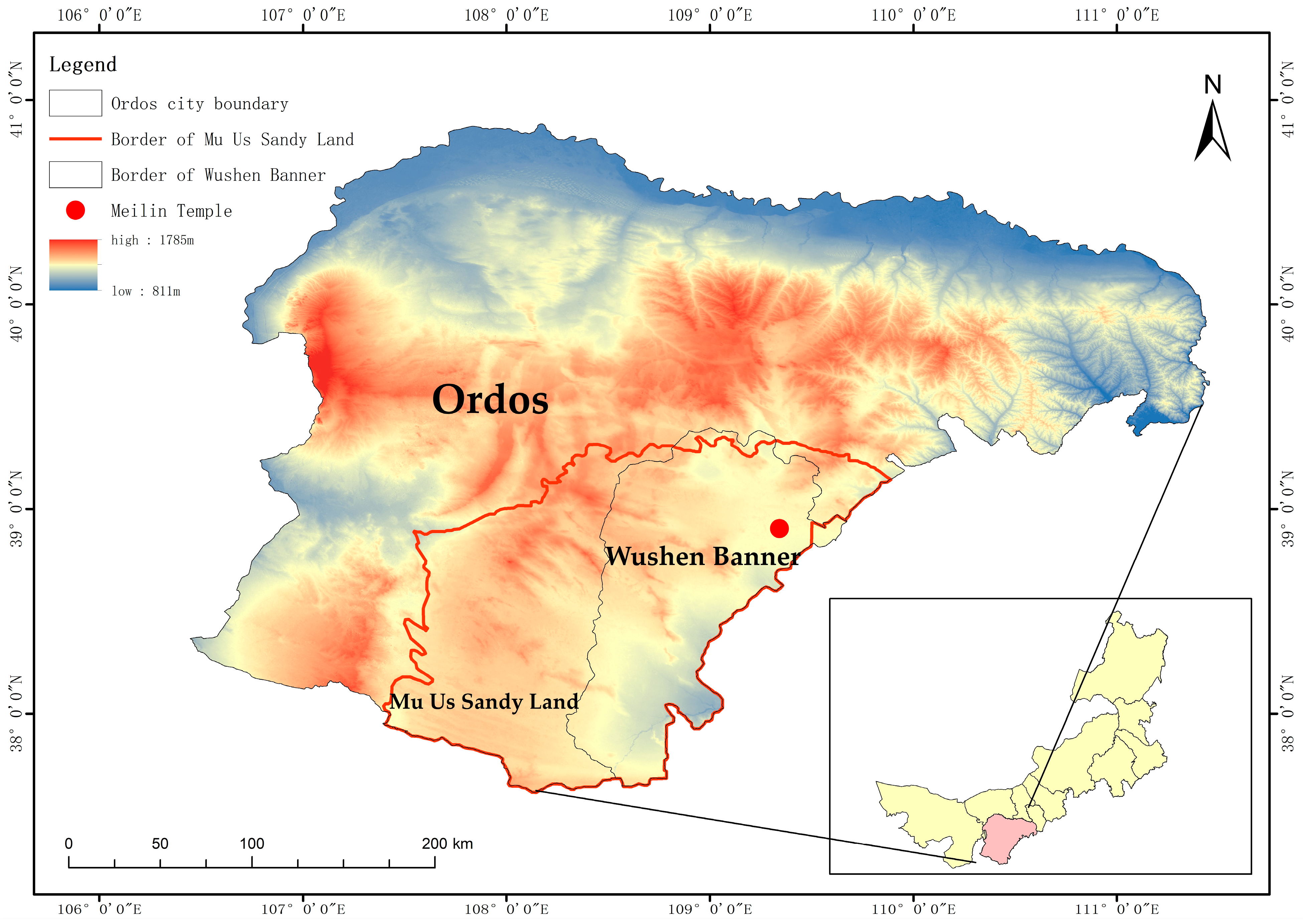

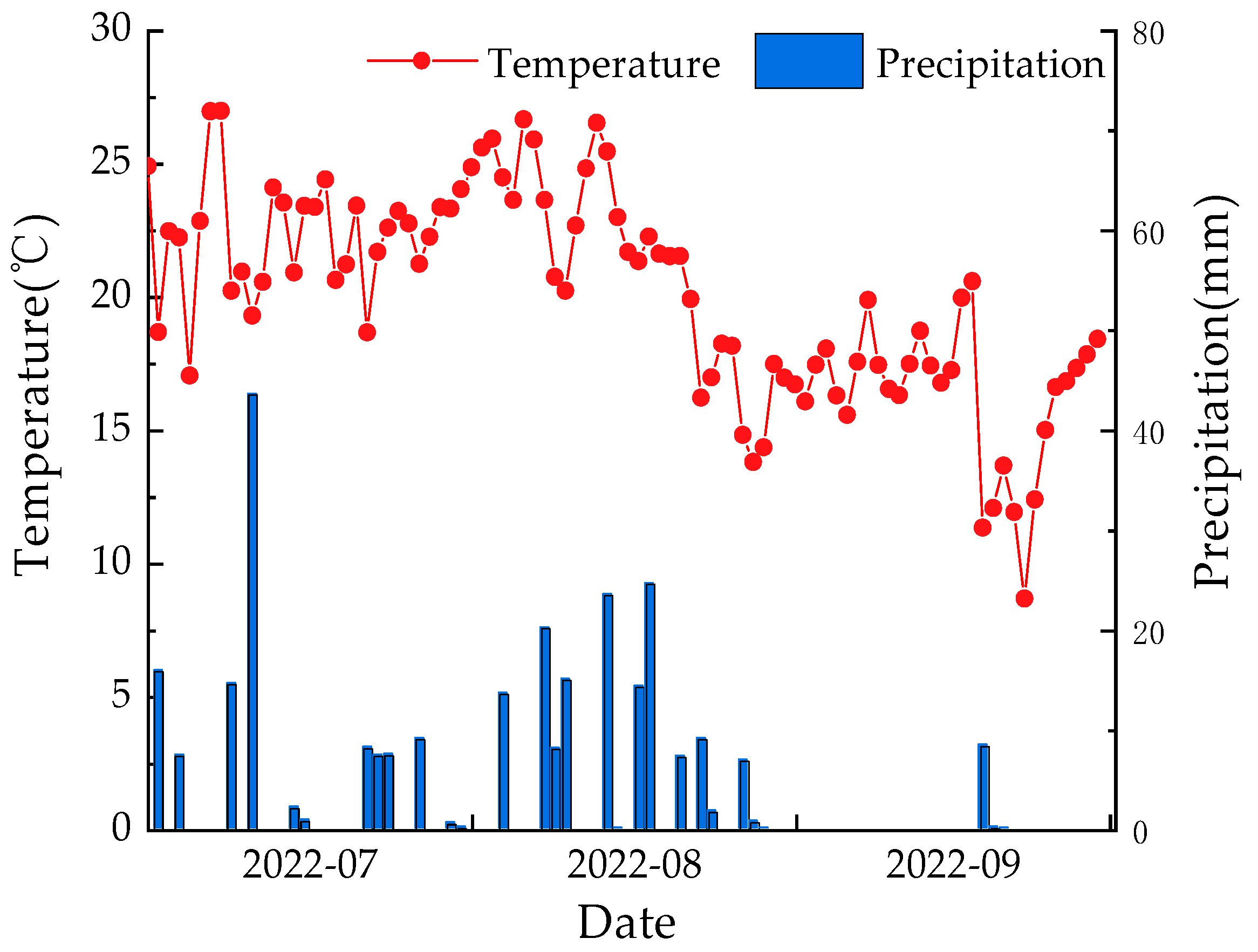

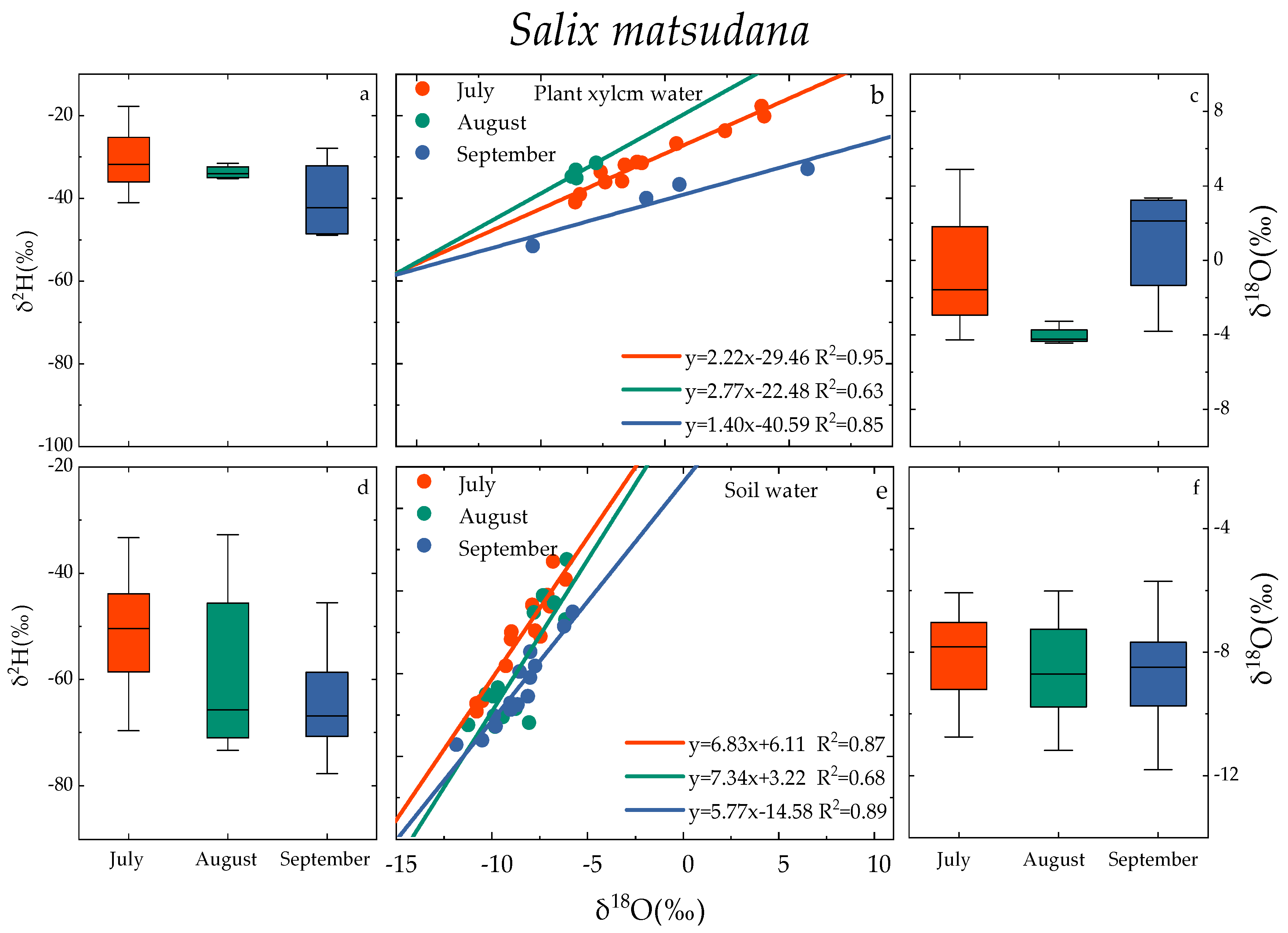
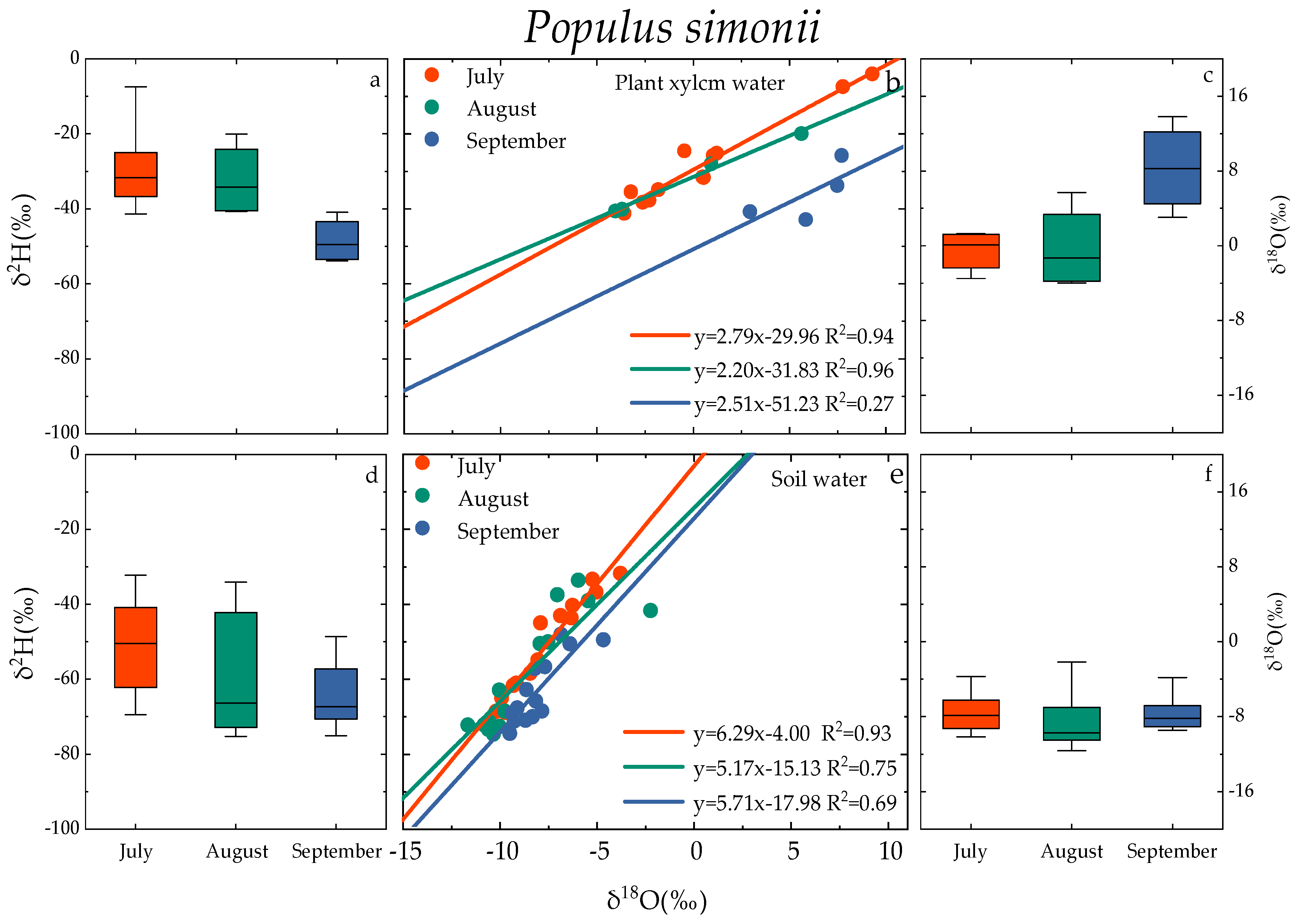
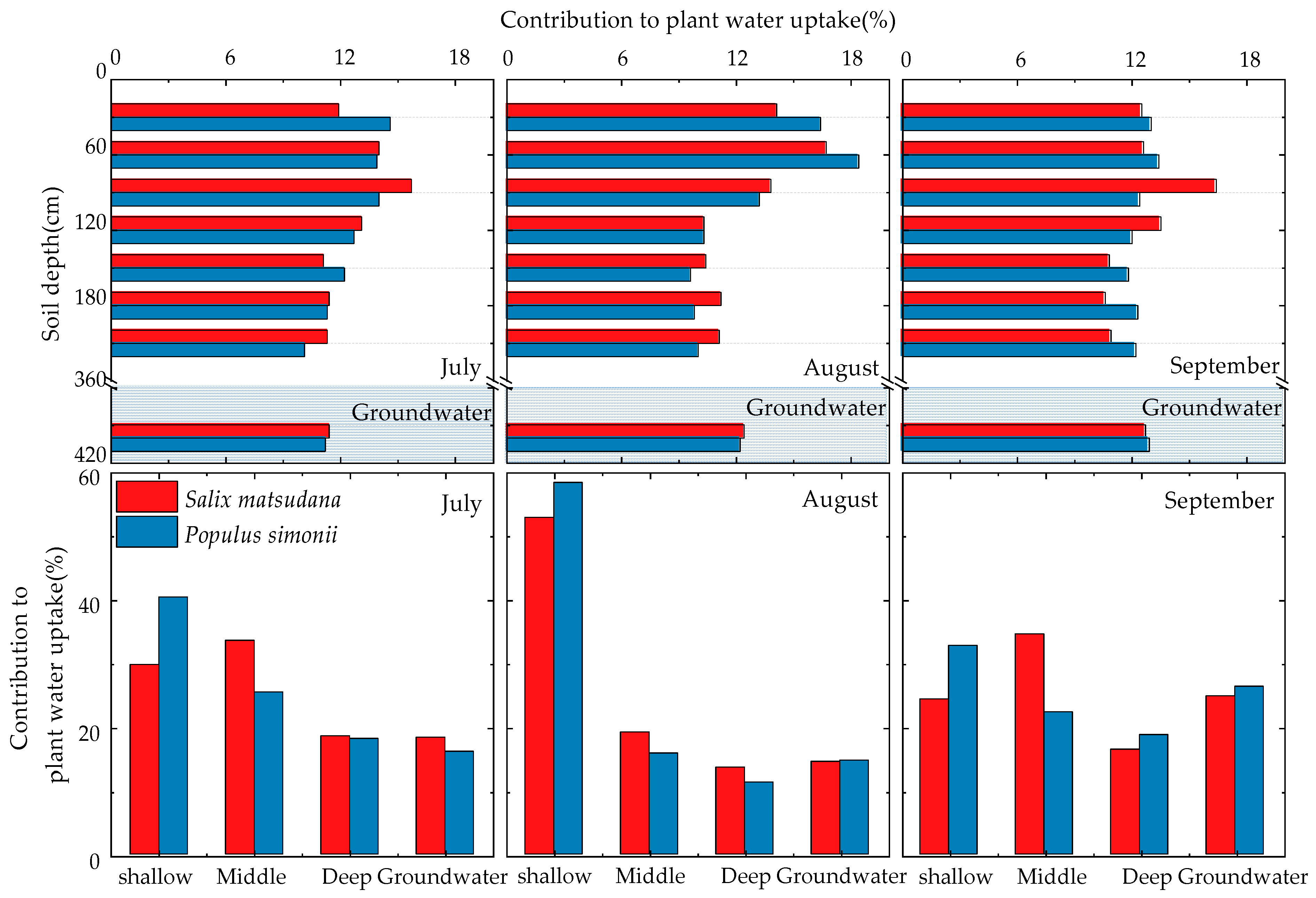
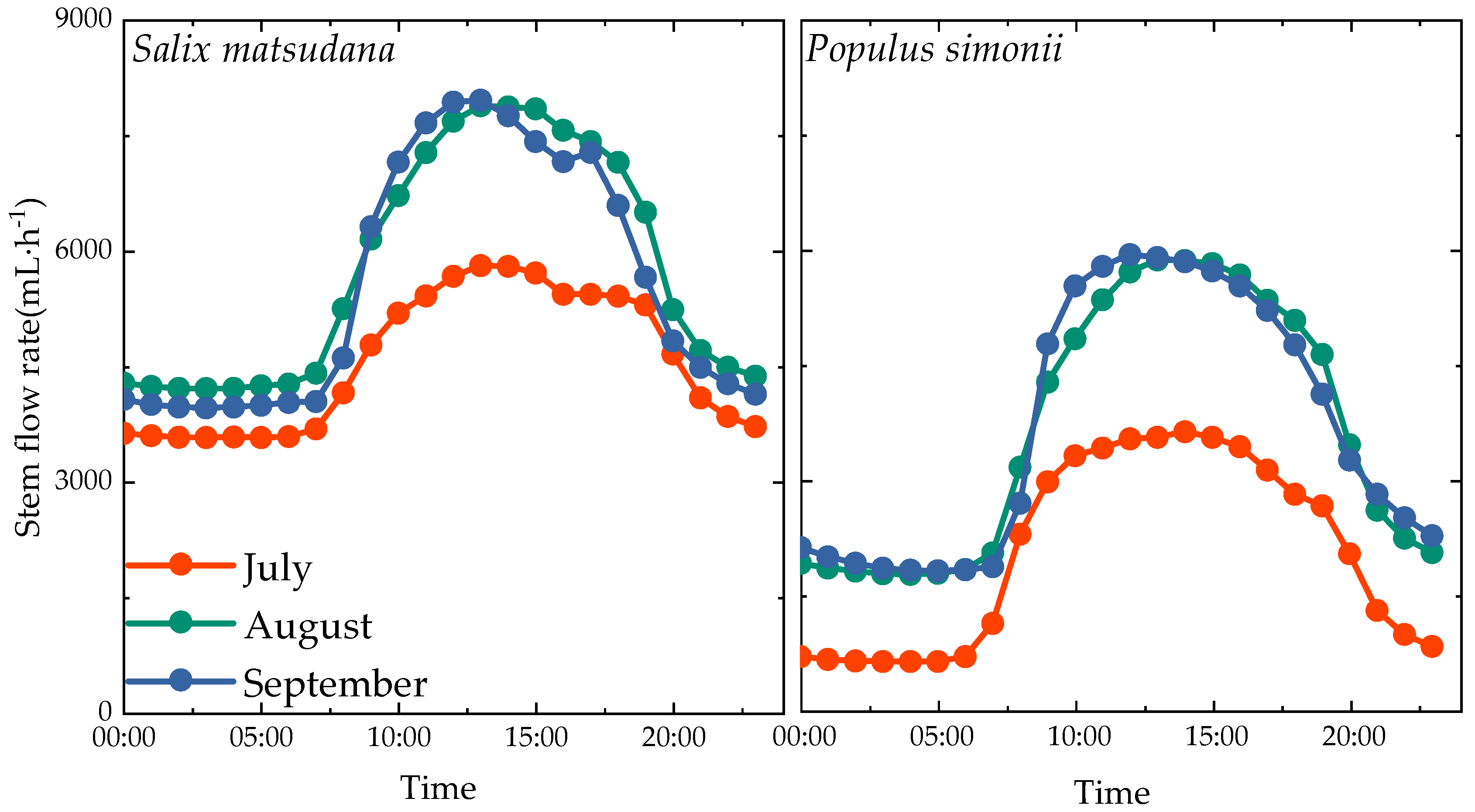

| Soil Depth (cm) | SOC (g/kg) | TN (g/kg) | TP (g/kg) | TK (g/kg) | Clay (%) | Silt (%) | Sand (%) |
|---|---|---|---|---|---|---|---|
| 0–30 | 3.64 | 0.48 | 0.40 | 3.53 | 2.78 | 5.54 | 91.68 |
| 30–60 | 2.25 | 0.42 | 0.44 | 4.02 | 4.28 | 13.18 | 82.53 |
| 60–90 | 1.56 | 0.36 | 0.37 | 3.45 | 10.94 | 27.13 | 61.92 |
| 90–120 | 2.19 | 0.19 | 0.24 | 3.58 | 8.72 | 25.4 | 65.88 |
| 120–150 | 2.02 | 0.48 | 0.34 | 7.70 | 1.44 | 3.4 | 95.16 |
| 150–180 | 1.96 | 0.08 | 0.20 | 2.18 | 1.51 | 2.8 | 95.69 |
| 180–210 | 2.06 | 0.07 | 0.17 | 1.80 | 2.54 | 5.36 | 92.1 |
Disclaimer/Publisher’s Note: The statements, opinions and data contained in all publications are solely those of the individual author(s) and contributor(s) and not of MDPI and/or the editor(s). MDPI and/or the editor(s) disclaim responsibility for any injury to people or property resulting from any ideas, methods, instructions or products referred to in the content. |
© 2023 by the authors. Licensee MDPI, Basel, Switzerland. This article is an open access article distributed under the terms and conditions of the Creative Commons Attribution (CC BY) license (https://creativecommons.org/licenses/by/4.0/).
Share and Cite
Zhai, Q.; Xu, L.; Zhang, T.; Guo, J.; Gao, H.; Jiao, R.; Yang, B. Transpiration Water Consumption by Salix matsudana and Populus simonii and Water Use Patterns at Different Developmental Stages on Sandy Land. Water 2023, 15, 4255. https://doi.org/10.3390/w15244255
Zhai Q, Xu L, Zhang T, Guo J, Gao H, Jiao R, Yang B. Transpiration Water Consumption by Salix matsudana and Populus simonii and Water Use Patterns at Different Developmental Stages on Sandy Land. Water. 2023; 15(24):4255. https://doi.org/10.3390/w15244255
Chicago/Turabian StyleZhai, Qiaoting, Li Xu, Tiegang Zhang, Jianying Guo, Haibo Gao, Rui Jiao, and Bo Yang. 2023. "Transpiration Water Consumption by Salix matsudana and Populus simonii and Water Use Patterns at Different Developmental Stages on Sandy Land" Water 15, no. 24: 4255. https://doi.org/10.3390/w15244255
APA StyleZhai, Q., Xu, L., Zhang, T., Guo, J., Gao, H., Jiao, R., & Yang, B. (2023). Transpiration Water Consumption by Salix matsudana and Populus simonii and Water Use Patterns at Different Developmental Stages on Sandy Land. Water, 15(24), 4255. https://doi.org/10.3390/w15244255






